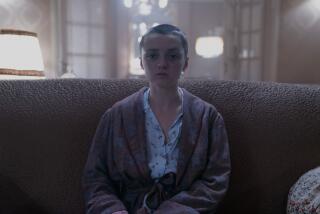Portrait of an Actress : SIMONE SIGNORET, <i> By Catherine David (Overlook Press: $22.95; 225 pp.)</i>
- Share via
In this era of hefty biographies Catherine David shows in her elegant and highly personal “Simone Signoret” that it is possible to capture the flavor of an individual’s life and personality in little more than 200 pages--even if that person lived as rich and full a life as Signoret did.
The Signoret that emerges in David’s book is pretty much what we might expect of the actress from all that’s been written about her and of her roles in such landmark films as “La Ronde,” “Casque d’Or,” “Room at the Top” and “Madame Rosa”: forthright, passionate, involved, a dedicated professional who was always much more than a movie star.
Born Simone Kaminker in 1921 to a Jewish father and a Gentile mother, whose maiden name she would appropriate, Signoret worked her way up through bit parts in films made during the Occupation--a hazardous course for someone half-Jewish. At the same time, beginning in early 1941, she became part of the Left Bank world of intellectuals and artists. This discovery and her meeting Yves Montand, the man she would marry, were the two major turning points of her life.
A protege of Edith Piaf, Montand was on his way to becoming a legendary singer whose one-man shows would be acclaimed the world over; eventually, he would become even better known as a major international screen star and a gifted actor. To the end of his life Montand would be an enduringly vital and attractive man, whereas Signoret, a sensual blond beauty in her youth, would age so rapidly that by the onset of the 1980s she looked 20 years older than she actually was. Catherine David, a reporter for the Nouvel Observateur in Paris, shows persuasively that this rush to embrace old age was triggered by a deep-seated hurt caused by Montand’s much-publicized affair with Marilyn Monroe, which occurred when they were cast in George Cukor’s “Let’s Make Love.”
Whereas David is eloquent and clear in outlining the Montands’ long-standing commitment to leftist causes, progressing from their naivete in regard to Eastern Europe and Russia in the 1950s to the human rights activism of their later years, she is at a loss in dealing with Hollywood in general and in particular with Monroe, who emerges as a caricature derived all too clearly from secondary sources. Intensely serious about the French cinema, David is so casual and dismissive about the American film industry that black-listed expatriate directors John Berry and Jules Dassin, the Belgian-born Mrs. Kirk Douglas and Claudette Colbert, who after all came to America from her native Paris at age 6, would all be surprised to find themselves described by David as being French.
David admires her subject to the point of being evasive on any point that might be construed as critical. She never describes Signoret as being an alcoholic until she tells us that she has stopped drinking due to declining health; she mentions a dark side to Signoret in her preface that she puts off dealing with until the final pages of her book. Where David is strongest is in her description of Signoret’s gradual emergence as a dedicated and serious writer, celebrated above all for her autobiography, “Nostalgia Isn’t What It Used to Be.” David believes that becoming a writer gave Signoret a crucial sense of fulfillment and even redemption. Although there are references throughout to individuals, places and events that would elude most American readers, “Simone Signoret” seems to have been exceptionally well-served by translator Sally Sampson.
More to Read
Sign up for our Book Club newsletter
Get the latest news, events and more from the Los Angeles Times Book Club, and help us get L.A. reading and talking.
You may occasionally receive promotional content from the Los Angeles Times.






